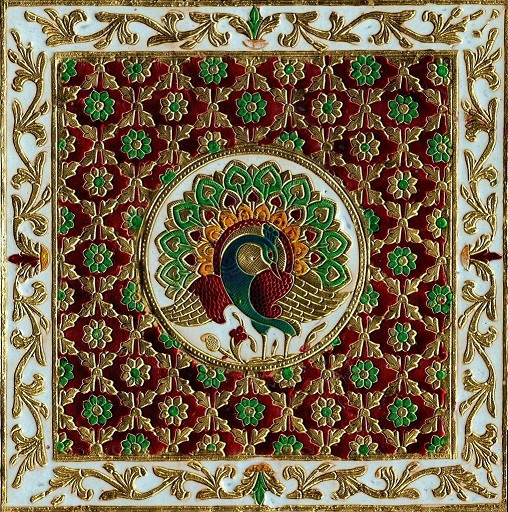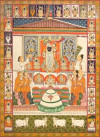India is the land of enriched culture and heritage. Music, applied arts, paintings, and colors of India have been popular for many years. From Kashmir to Kanyakumari, a variety of art styles flourished in this country at different times. People of India even celebrate their festivals by using vibrant colors and eminent artworks. These practices are treated as an integral part of our enriched cultures. Meenakari is one of the most popular as well as vibrant artworks that generally belong to the land of Rajasthan. By using different precious metals and stones, artists developed a piece of Meenakari art. Spectacular patterns, designs, themes, and motifs make this artwork special. Meenakari art's relationship with Rajputana is close and longstanding. Many Rajput rulers support this artwork many times. Still, many foreign visitors and art enthusiasts travel to Rajasthan to observe the excitement of making Meenakari art and collect some masterpieces as a memorandum.
Exclusive background of Meenakari:
Meenakari is the unique art and process of designing on metallic surfaces. Embellishing various kinds of precious metals such as gold, silver, copper or bronze makes the art attractive. You can easily find an intensive sense of art and outstanding color combinations. Usually, this artwork is done with various vibrant colors in spectacular themes, patterns, and designs of animals, birds, fishes, leaves, flowers, and some other living objects. According to the concept of many experts, it can be coined as the practice of painting and designing on metal surfaces as well as ceramic tiles through advanced-level enameling. Meenakari is broadly accepted and an old-fashioned technology that is mainly used in decorative art and jewelry making.
In ancient Iran and Mesopotamia, enameling was only done on silver and gold to make spectacular designs and exclusive artworks. However, today, enameling is also done on other precious metals such as bronze and copper.
History- Behind the Curtain:
The process of enameling is used to paint ceramic tiles and metal surfaces in this classic Meenakari art form. This unique art form originated during the reign of the greatest Iranian empires, Safavid Iran or Safavid Persia. In the initial days, this art form was widely practiced and commercially produced, especially in Iran and Gandhar (currently known as Afghanistan provinces). After that this artwork became popular in different areas of Pakistan and India also. Iranian craftspeople developed the meenakari art form in Persia. Greeks, Russians, Chinese, and even Mughals all embraced it. Before the period of the Mughal empire, this art form was completely unfamiliar and unknown to Indians. Mughals and Rajput kings introduced this to the native people of India.
Some historians opined that Raja Man Sigh of Amber introduced this technique and he brought craftsmen from Persia to Lahore and Rajasthan in the 16th century CE and gave the Indian flavor as well as an explicit look to this artwork through Mughal patronage. The prosperous period of Meenakari was a result of the tight relationship between the Rajput and the Mughals. As time went on, Jaipur evolved into the center of Meenakari and developed its own unique Champlevé enameling technique, which is characterized by its rich red hue.
Meena, the feminine version of the Persian word Minoo, is where the word "Meenakari" comes from. Its meanings include "heaven" and "Kari", which means to do or apply, respectively. Thus, the meaning of the word "Meenakari" is to affix or apply paradise to something.
Different Styles of Meenakari:
The Meenakari art generally involves covering metallic objects with rich coloured enamels. Used metals are called Chitras. Usually, there are various types of Meenakari art materials found in the market of India, Pakistan and Afghanistan.
- Panch Rang Mina: This Meenakari Art uses five color enamels including Safed (opaque white), Khula Sabz (transparent green), Khula Nila (transparent dark blue), Fakhata (dove) and Fakhtai (opaque light blue).
- Ek Rang Khula Mina: Usually, this method includes the usage of single colour transparent enamel. While making this Meenakari art, engraved areas are filled with a particular enamel leaving bright gold coloured outlines around figural details.
- Gulabi Meena: For making Gulabi Meena, artists use pink enamels which are derived from Rose (Gulab). In different areas of Varanasi, this form of Meenakari art is widely prevalent. Usually, transparent pink-coloured enamel is painted on the surface of the white opaque background. This pink enamel is mostly used for painting floral designs and themes. Areas other than floral decorations are painted and coloured by using the 'champleve' style. So it can be said that Gulabi Meena is a style of mixed enameling.
Process of Making Meenakari:
The overall process of making a piece of Meenakari art is very long, complicated, and complex. To make perfect meenakari art, an artist requires lots of materials, skills, and obviously serious dedication. The process of making Meenakari art involves fusing powder glass with metal, ceramic, or glass. Making a plate or designed frame is done through intense heat, typically between 750-degree to 850-degree Celsius. This gives the substance the names porcelain enamel or vitreous enamel. On metal, glass, or ceramics, the powder melts, spreads, and then forms a smooth, resilient, and vitreous coating.
Any stone, metal, substance, or item that can endure and withstand fusing temperatures can be coated with enamel. After completing these stages, the metal pieces are fixed on a sharp lack stick on which Meenakari is to be done properly. The main important stage for making a Meenakari painting is detailing. The beautiful and elegant designs of flowers, fishes, birds flora, fauna, and other living objects are engraved and carved during this stage. The heat of the kiln melts the used colors. As a result, the melted color spreads evenly into the total groove.
Usage of Meenakari:
Due to its eye-catching and striking features, Meenakari art forms a variety of products such as earrings, anklets, necklaces, jewelry boxes, key chains, photo frames, chairs, and small show-case temples. In Gujrat and Rajasthan, Meenakari articles and jewelry are famous and coined as the main center of attraction of these articles. Apart from making jewelry and showpieces, Meenakari arts are also used for decorating large artworks such as wall paintings and frescoes.
Current Situations of Meenakari:
The manufacturing of jewelry has been significantly impacted by changing times and public demands. However, the essence of making jewelry becomes creative due to the change in time. Instead of heavy jewelry, people are liking to use lightweight and simple style jewelry. It has been also identified that people are tending various types of ancient art styles in their jewelry and interior design. In the era of modernization, the demand for Meenakari art was mainly found in the jewelry industry rather than in interior design. Due to the high cost of precious stones and metals, Meenakari art becomes limited only to the jewelry industry.
Bottom Lines:
Many art lovers across India like to get this art form on their ornaments. Today, Jaipur tries to continue the practices of this artwork and maintain the art hub for Stone Carving, Enamelling, and Meenakari art. In some past decades, the demands of Meenakari art fell due to the lack of proper advertising and promotion. Many online platforms such as ARTSofINDIA.in try to promote this artwork in front of international buyers. As a result, many native people and foreigners increased the demand for Meenakari art during this decade. Apart from Rajasthan-based Meenakari works, Meenakars of Lucknow and Varanasi try to make a global market through digital platforms and social media.
Picture Source: Pinterest



